Detecting Fatigue during Exoskeleton-Assisted Trunk Flexion Tasks: A Machine Learning Approach
Abstract
1. Introduction
2. Materials and Methods
2.1. Participants
2.2. Approach
2.2.1. Experimental Tasks
2.2.2. Exoskeleton Device
2.2.3. Data Acquisition
2.3. Experimental Design and Procedure
2.4. Data Pre-Processing and Feature Engineering
2.5. Classification Algorithms and Model Development
2.6. Performance Evaluation
3. Results
3.1. Differences across Classification Algorithms and Measures
3.2. Feature Importance Values
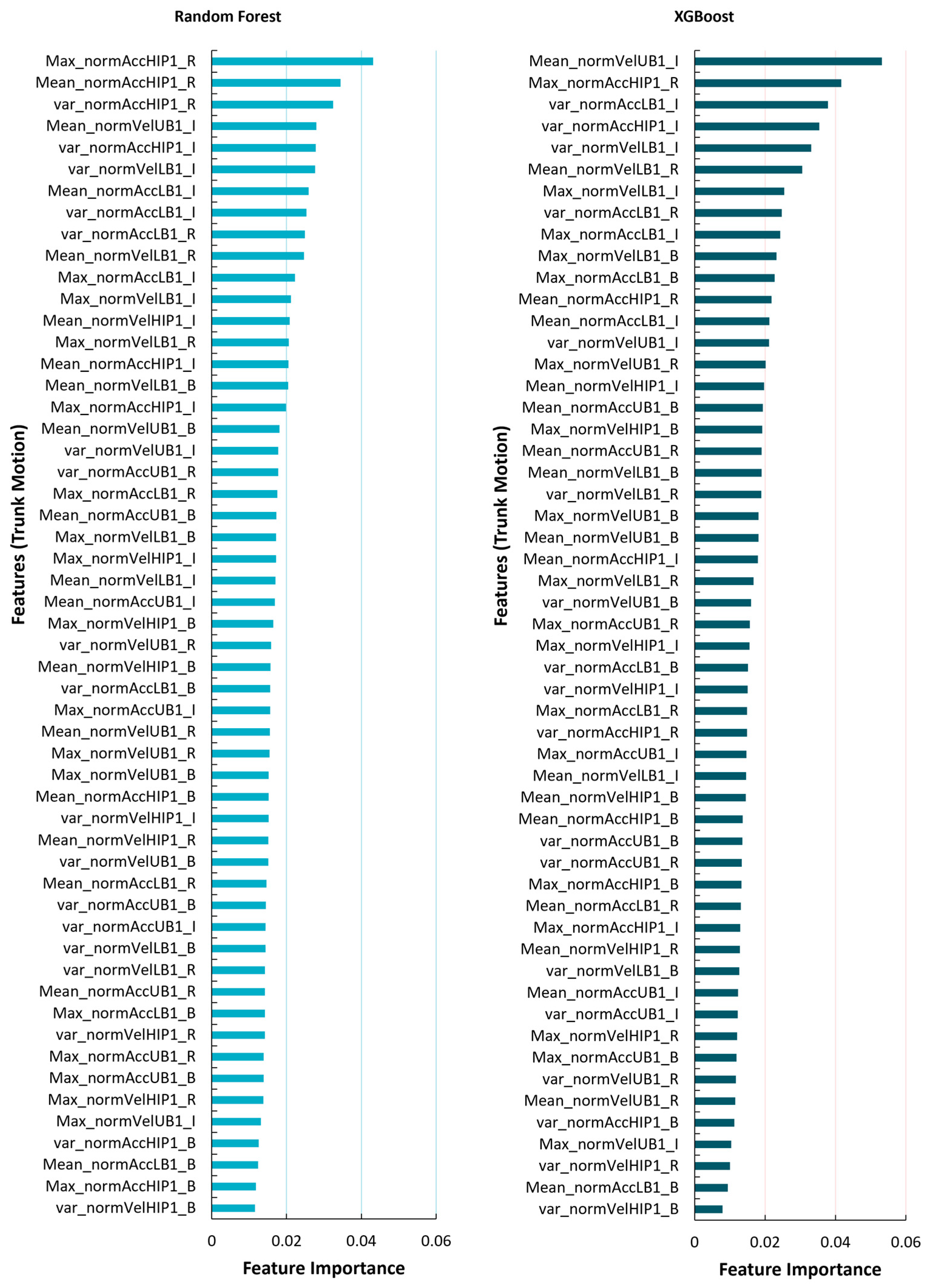
4. Discussion
5. Conclusions
Author Contributions
Funding
Institutional Review Board Statement
Informed Consent Statement
Data Availability Statement
Conflicts of Interest
References
- Bureau of Labor Statistics. Employer Reported Workplace Injuries and Illnesses; US Department of Labour: Washington, DC, USA, 2023.
- Caputo, F.; Di Gironimo, G.; Marzano, A. Ergonomic Optimization of a Manufacturing System Work Cell in a Virtual Environment. Acta Polytech. 2006, 46, 5. [Google Scholar] [CrossRef] [PubMed]
- Workineh, S.A.; Yamaura, H. Multi-Position Ergonomic Computer Workstation Design to Increase Comfort of Computer Work. Int. J. Ind. Ergon. 2016, 53, 1–9. [Google Scholar] [CrossRef]
- Dubina, K.S.; Ice, L.; Kim, J.-L.; Rieley, M.J. Projections Overview and Highlights, 2020–30; Bureau of Labor Statistics: Washington, DC, USA, 2021.
- Kuber, P.M.; Alemi, M.M.; Rashedi, E. A Systematic Review on Lower-Limb Industrial Exoskeletons: Evaluation Methods, Evidence, and Future Directions. Ann. Biomed. Eng. 2023, 51, 1665–1682. [Google Scholar] [CrossRef] [PubMed]
- Kuber, P.M.; Abdollahi, M.; Alemi, M.M.; Rashedi, E. A Systematic Review on Evaluation Strategies for Field Assessment of Upper-Body Industrial Exoskeletons: Current Practices and Future Trends. Ann. Biomed. Eng. 2022, 50, 1203–1231. [Google Scholar] [CrossRef] [PubMed]
- Bureau of Labor Statistics. Incidence Rates for Occupational Injuries and Illnesses with Days Away from Work by Selected Occupations; Bureau of Labor Statistics: Washington, DC, USA, 2016.
- Bosch, T.; van Eck, J.; Knitel, K.; de Looze, M. The Effects of a Passive Exoskeleton on Muscle Activity, Discomfort and Endurance Time in Forward Bending Work. Appl. Ergon. 2016, 54, 212–217. [Google Scholar] [CrossRef] [PubMed]
- Graham, R.B.; Agnew, M.J.; Stevenson, J.M. Effectiveness of an On-Body Lifting Aid at Reducing Low Back Physical Demands during an Automotive Assembly Task: Assessment of EMG Response and User Acceptability. Appl. Ergon. 2009, 40, 936–942. [Google Scholar] [CrossRef]
- Yap, H.K.; Ng, H.Y.; Yeow, C.-H. High-Force Soft Printable Pneumatics for Soft Robotic Applications. Soft Robot. 2016, 3, 144–158. [Google Scholar] [CrossRef]
- Kang, S.H.; Mirka, G.A. Effect of Trunk Flexion Angle and Time on Lumbar and Abdominal Muscle Activity While Wearing a Passive Back-Support Exosuit Device during Simple Posture-Maintenance Tasks. Ergonomics 2023, 66, 2182–2192. [Google Scholar] [CrossRef]
- Kazerooni, H.; Tung, W.; Pillai, M. Evaluation of Trunk-Supporting Exoskeleton. In Proceedings of the Human Factors and Ergonomics Society Annual Meeting 2019, Washington, DC, USA, 28 October–1 November 2019; Volume 63, pp. 1080–1083. [Google Scholar] [CrossRef]
- Kermavnar, T.; de Vries, A.W.; de Looze, M.P.; O’Sullivan, L.W. Effects of Industrial Back-Support Exoskeletons on Body Loading and User Experience: An Updated Systematic Review. Ergonomics 2021, 64, 685–711. [Google Scholar] [CrossRef]
- Poliero, T.; Sposito, M.; Toxiri, S.; Di Natali, C.; Iurato, M.; Sanguineti, V.; Caldwell, D.G.; Ortiz, J. Versatile and Non-Versatile Occupational Back-Support Exoskeletons: A Comparison in Laboratory and Field Studies. Wearable Technol. 2021, 2, e12. [Google Scholar] [CrossRef]
- Baltrusch, S.J.; van Dieën, J.H.; Bruijn, S.M.; Koopman, A.S.; van Bennekom, C.A.M.; Houdijk, H. The Effect of a Passive Trunk Exoskeleton on Metabolic Costs during Lifting and Walking. Ergonomics 2019, 62, 903–916. [Google Scholar] [CrossRef] [PubMed]
- Schmalz, T.; Colienne, A.; Bywater, E.; Fritzsche, L.; Gärtner, C.; Bellmann, M.; Reimer, S.; Ernst, M. A Passive Back-Support Exoskeleton for Manual Materials Handling: Reduction of Low Back Loading and Metabolic Effort during Repetitive Lifting. IISE Trans. Occup. Ergon. Hum. Factors 2022, 10, 7–20. [Google Scholar] [CrossRef]
- Koopman, A.S.; Toxiri, S.; Power, V.; Kingma, I.; van Dieën, J.H.; Ortiz, J.; de Looze, M.P. The Effect of Control Strategies for an Active Back-Support Exoskeleton on Spine Loading and Kinematics during Lifting. J. Biomech. 2019, 91, 14–22. [Google Scholar] [CrossRef] [PubMed]
- Abdoli-E, M.; Stevenson, J.M. The Effect of On-Body Lift Assistive Device on the Lumbar 3D Dynamic Moments and EMG during Asymmetric Freestyle Lifting. Clin. Biomech. 2008, 23, 372–380. [Google Scholar] [CrossRef]
- Tyagi, O.; Rana Mukherjee, T.; Mehta, R.K. Neurophysiological, Muscular, and Perceptual Adaptations of Exoskeleton Use over Days during Overhead Work with Competing Cognitive Demands. Appl. Ergon. 2023, 113, 104097. [Google Scholar] [CrossRef] [PubMed]
- Butkeviçiüte, E.; Erinš, M.; Bikulçiene, L. An Adaptable Human Fatigue Evaluation System. Procedia Comput. Sci. 2021, 192, 1274–1284. [Google Scholar] [CrossRef]
- Williams, N. The Borg Rating of Perceived Exertion (RPE) Scale. Occup. Med. 2017, 67, 404–405. [Google Scholar] [CrossRef]
- Stastny, P.; Gołaś, A.; Blazek, D.; Maszczyk, A.; Wilk, M.; Pietraszewski, P.; Petr, M.; Uhlir, P.; Zajac, A. A Systematic Review of Surface Electromyography Analyses of the Bench Press Movement Task. PLoS ONE 2017, 12, e0171632. [Google Scholar] [CrossRef]
- Park, J.H.; Kim, S.; Nussbaum, M.A.; Srinivasan, D. Effects of Two Passive Back-Support Exoskeletons on Postural Balance during Quiet Stance and Functional Limits of Stability. J. Electromyogr. Kinesiol. 2021, 57, 102516. [Google Scholar] [CrossRef]
- Dolan, P.; Adams, M.A. Repetitive Lifting Tasks Fatigue the Back Muscles and Increase the Bending Moment Acting on the Lumbar Spine. J. Biomech. 1998, 31, 713–721. [Google Scholar] [CrossRef]
- Jeon, S.; Lee, S.-M.; Kim, J. Therapeutic Effects of Reaching with Forward Bending of Trunk on Postural Stability, Dynamic Balance, and Gait in Individuals with Chronic Hemiparetic Stroke. J. Phys. Ther. Sci. 2015, 27, 2447–2451 5p. [Google Scholar] [CrossRef]
- Picchiotti, M.T.; Weston, E.B.; Knapik, G.G.; Dufour, J.S.; Marras, W.S. Impact of Two Postural Assist Exoskeletons on Biomechanical Loading of the Lumbar Spine. Appl. Ergon. 2019, 75, 1–7. [Google Scholar] [CrossRef]
- Kuber, P.M.; Rashedi, E. Product Ergonomics in Industrial Exoskeletons: Potential Enhancements for Workforce Safety and Efficiency. Theor. Issues Ergon. Sci. 2020, 22, 729–752. [Google Scholar] [CrossRef]
- Kuber, P.M.; Rashedi, E. Towards Reducing Risk of Injury in Nursing: Design and Analysis of a New Passive Exoskeleton for Torso Twist Assist. Proc. Int. Symp. Hum. Factors Ergon. Health Care 2021, 10, 217–222. [Google Scholar] [CrossRef]
- Wuest, T.; Weimer, D.; Irgens, C.; Thoben, K.D. Machine Learning in Manufacturing: Advantages, Challenges, and Applications. Prod. Manuf. Res. 2016, 4, 23–45. [Google Scholar] [CrossRef]
- Shafighfard, T.; Kazemi, F.; Bagherzadeh, F.; Mieloszyk, M.; Yoo, D.Y. Chained Machine Learning Model for Predicting Load Capacity and Ductility of Steel Fiber–Reinforced Concrete Beams. Comput. Civ. Infrastruct. Eng. 2024, 1–22. [Google Scholar] [CrossRef]
- Rush, B.; Celi, L.A.; Stone, D.J. Applying Machine Learning to Continuously Monitored Physiological Data. J. Clin. Monit. Comput. 2019, 33, 887–893. [Google Scholar] [CrossRef] [PubMed]
- Bharadwaj, H.K.; Agarwal, A.; Chamola, V.; Lakkaniga, N.R.; Hassija, V.; Guizani, M.; Sikdar, B. A Review on the Role of Machine Learning in Enabling IoT Based Healthcare Applications. IEEE Access 2021, 9, 38859–38890. [Google Scholar] [CrossRef]
- Halilaj, E.; Rajagopal, A.; Fiterau, M.; Hicks, J.L.; Hastie, T.J.; Delp, S.L. Machine Learning in Human Movement Biomechanics: Best Practices, Common Pitfalls, and New Opportunities. J. Biomech. 2018, 81, 1–11. [Google Scholar] [CrossRef]
- Gurchiek, R.D.; Cheney, N.; McGinnis, R.S. Estimating Biomechanical Time-Series with Wearable Sensors: A Systematic Review of Machine Learning Techniques. Sensors 2019, 19, 5227. [Google Scholar] [CrossRef]
- Matijevich, E.S.; Volgyesi, P.; Zelik, K.E. A Promising Wearable Solution for the Practical and Accurate Monitoring of Low Back Loading in Manual Material Handling. Sensors 2021, 21, 340. [Google Scholar] [CrossRef] [PubMed]
- Ramos, G.; Vaz, J.R.; Mendonça, G.V.; Pezarat-Correia, P.; Rodrigues, J.; Alfaras, M.; Gamboa, H.; Zou, L. Fatigue Evaluation through Machine Learning and a Global Fatigue Descriptor. J. Healthc. Eng. 2020, 2020, 6484129. [Google Scholar] [CrossRef] [PubMed]
- Scherpereel, K.L.; Bolus, N.B.; Jeong, H.K.; Inan, O.T.; Young, A.J. Estimating Knee Joint Load Using Acoustic Emissions During Ambulation. Ann. Biomed. Eng. 2021, 49, 1000–1011. [Google Scholar] [CrossRef] [PubMed]
- Abdollahi, M.; Rashedi, E.; Jahangiri, S.; Kuber, P.M.; Azadeh-Fard, N.; Dombovy, M. Fall Risk Assessment in Stroke Survivors: A Machine Learning Model Using Detailed Motion Data from Common Clinical Tests and Motor-Cognitive Dual-Tasking. Sensors 2024, 24, 812. [Google Scholar] [CrossRef] [PubMed]
- Kazemi, F.; Asgarkhani, N.; Jankowski, R. Machine Learning-Based Seismic Fragility and Seismic Vulnerability Assessment of Reinforced Concrete Structures. Soil Dyn. Earthq. Eng. 2023, 166, 107761. [Google Scholar] [CrossRef]
- Liu, G.; Dobbins, C.; D’Souza, M.; Phuong, N. A Machine Learning Approach for Detecting Fatigue during Repetitive Physical Tasks. Pers. Ubiquitous Comput. 2023, 27, 2103–2120. [Google Scholar] [CrossRef]
- Aguirre, A.; Pinto, M.J.; Cifuentes, C.A.; Perdomo, O.; Díaz, C.A.R.; Múnera, M. Machine Learning Approach for Fatigue Estimation in Sit-to-Stand Exercise. Sensors 2021, 21, 5006. [Google Scholar] [CrossRef] [PubMed]
- Baghdadi, A.; Megahed, F.M.; Esfahani, E.T.; Cavuoto, L.A. A Machine Learning Approach to Detect Changes in Gait Parameters Following a Fatiguing Occupational Task. Ergonomics 2018, 61, 1116–1129. [Google Scholar] [CrossRef] [PubMed]
- Pinto-Bernal, M.J.; Cifuentes, C.A.; Perdomo, O.; Rincón-Roncancio, M.; Múnera, M. A Data-Driven Approach to Physical Fatigue Management Using Wearable Sensors to Classify Four Diagnostic Fatigue States. Sensors 2021, 21, 6401. [Google Scholar] [CrossRef]
- Figueiredo, J.; Santos, C.P.; Moreno, J.C. Automatic Recognition of Gait Patterns in Human Motor Disorders Using Machine Learning: A Review. Med. Eng. Phys. 2018, 53, 1–12. [Google Scholar] [CrossRef]
- Karthick, P.A.; Ghosh, D.M.; Ramakrishnan, S. Surface Electromyography Based Muscle Fatigue Detection Using High-Resolution Time-Frequency Methods and Machine Learning Algorithms. Comput. Methods Programs Biomed. 2018, 154, 45–56. [Google Scholar] [CrossRef] [PubMed]
- Antwi-Afari, M.F.; Anwer, S.; Umer, W.; Mi, H.Y.; Yu, Y.; Moon, S.; Hossain, M.U. Machine Learning-Based Identification and Classification of Physical Fatigue Levels: A Novel Method Based on a Wearable Insole Device. Int. J. Ind. Ergon. 2023, 93, 103404. [Google Scholar] [CrossRef]
- Zhou, Q.X.; Chen, Y.H.; Ma, C.; Zheng, X.H. Evaluation of Upper Limb Muscle Fatigue Based on Surface Electromyography. Sci. China Life Sci. 2011, 54, 939–944. [Google Scholar] [CrossRef] [PubMed][Green Version]
- Karg, M.; Venture, G.; Hoey, J.; Kulic, D. Human Movement Analysis as a Measure for Fatigue: A Hidden Markov-Based Approach. IEEE Trans. Neural Syst. Rehabil. Eng. 2014, 22, 470–481. [Google Scholar] [CrossRef] [PubMed]
- Chen, S.W.; Liaw, J.W.; Chan, H.L.; Chang, Y.J.; Ku, C.H. A Real-Time Fatigue Monitoring and Analysis System for Lower Extremity Muscles with Cycling Movement. Sensors 2014, 14, 12410. [Google Scholar] [CrossRef] [PubMed]
- Zhang, L.; Diraneyya, M.M.; Ryu, J.; Haas, C.T.; Abdel-Rahman, E. Assessment of Jerk As a Method of Physical Fatigue Detection; American Society of Mechanical Engineers: New York, NY, USA, 2018. [Google Scholar] [CrossRef]
- Jiang, Y.; Hernandez, V.; Venture, G.; Kulić, D.; Chen, B.K. A Data-Driven Approach to Predict Fatigue in Exercise Based on Motion Data from Wearable Sensors or Force Plate. Sensors 2021, 21, 1499. [Google Scholar] [CrossRef] [PubMed]
- Ameli, S.; Stirling, D.; Naghdy, F.; Naghdy, G.; Aghmesheh, M. Assessing the Impact of Fatigue on Gait Using Inertial Sensors. In Proceedings of the 2013 IEEE/ASME International Conference on Advanced Intelligent Mechatronics, AIM 2013, Wollongong, Australia, 9–12 July 2013; pp. 307–312. [Google Scholar] [CrossRef]
- Hernandez, G.; Valles, D.; Wierschem, D.C.; Koldenhoven, R.M.; Koutitas, G.; Mendez, F.A.; Aslan, S.; Jimenez, J. Machine Learning Techniques for Motion Analysis of Fatigue from Manual Material Handling Operations Using 3D Motion Capture Data. In Proceedings of the 2020 10th Annual Computing and Communication Workshop and Conference CCWC 2020, Las Vegas, NV, USA, 6–8 January 2020; pp. 300–305. [Google Scholar] [CrossRef]
- Karvekar, S.; Abdollahi, M.; Rashedi, E. Smartphone-Based Human Fatigue Level Detection Using Machine Learning Approaches. Ergonomics 2020, 64, 600–612. [Google Scholar] [CrossRef]
- Nakane, H.; Toyama, J.; Kudo, M. Fatigue Detection Using a Pressure Sensor Chair. In Proceedings of the 2011 IEEE International Conference on Granular Computing, GrC 2011, Kaohsiung, Taiwan, 8–10 November 2011; pp. 490–495. [Google Scholar] [CrossRef]
- Troester, J.C.; Jasmin, J.G.; Duffield, R. Reliability of Single-Leg Balance and Landing Tests in Rugby Union; Prospect of Using Postural Control to Monitor Fatigue. J. Sport Sci. Med. 2018, 17, 174–180. [Google Scholar]
- Antwi-Afari, M.F.; Li, H.; Edwards, D.J.; Pärn, E.A.; Seo, J.; Wong, A.Y.L. Biomechanical Analysis of Risk Factors for Work-Related Musculoskeletal Disorders during Repetitive Lifting Task in Construction Workers. Autom. Constr. 2017, 83, 41–47. [Google Scholar] [CrossRef]
- SENIAM Project (Surface ElectroMyoGraphy for the Non-Invasive Assessment of Muscles). Available online: http://www.seniam.org/ (accessed on 17 October 2023).
- VICON Nexus Documentation. Available online: https://docs.vicon.com/display/Nexus212/Nexus+Documentation (accessed on 17 October 2023).
- Rashedi, E.; Kim, S.; Nussbaum, M.A.; Agnew, M.J. Ergonomic Evaluation of a Wearable Assistive Device for Overhead Work. Ergonomics 2014, 57, 1864–1874. [Google Scholar] [CrossRef]
- Hefferle, M.; Snell, M.; Kluth, K. Influence of Two Industrial Overhead Exoskeletons on Perceived Strain—A Field Study in the Automotive Industry; Springer International Publishing: Berlin/Heidelberg, Germany, 2021; Volume 1210 AISC, ISBN 9783030517571. [Google Scholar]
- Jia, B.; Kim, S.; Nussbaum, M.A. An EMG-Based Model to Estimate Lumbar Muscle Forces and Spinal Loads during Complex, High-Effort Tasks: Development and Application to Residential Construction Using Prefabricated Walls. Int. J. Ind. Ergon. 2011, 41, 437–446. [Google Scholar] [CrossRef]
- Heydari, H.; Hoviattalab, M.; Azghani, M.R.; Ramezanzadehkoldeh, M.; Parnianpour, M. Investigation on a Developed Wearable Assistive Device (WAD) in Reduction Lumbar Muscles Activity. Biomed. Eng. Appl. Basis Commun. 2013, 25, 1350035. [Google Scholar] [CrossRef]
- Sun, R.; Hsieh, K.L.; Sosnoff, J.J. Fall Risk Prediction in Multiple Sclerosis Using Postural Sway Measures: A Machine Learning Approach. Sci. Rep. 2019, 9, 16154. [Google Scholar] [CrossRef] [PubMed]
- Dedering, Å.; Németh, G.; Harms-Ringdahl, K. Correlation between Electromyographic Spectral Changes and Subjective Assessment of Lumbar Muscle Fatigue in Subjects without Pain from the Lower Back. Clin. Biomech. 1999, 14, 103–111. [Google Scholar] [CrossRef] [PubMed]
- Hummel, A.; Läubli, T.; Pozzo, M.; Schenk, P.; Spillmann, S.; Klipstein, A. Relationship between Perceived Exertion and Mean Power Frequency of the EMG Signal from the Upper Trapezius Muscle during Isometric Shoulder Elevation. Eur. J. Appl. Physiol. 2005, 95, 321–326. [Google Scholar] [CrossRef] [PubMed]
- Bae, J.; Kong, K.; Byl, N.; Tomizuka, M. A Mobile Gait Monitoring System for Abnormal Gait Diagnosis and Rehabilitation: A Pilot Study for Parkinson Disease Patients. J. Biomech. Eng. 2011, 133, 041005. [Google Scholar] [CrossRef] [PubMed]
- Calzavara, M.; Persona, A.; Sgarbossa, F.; Visentin, V. A Device to Monitor Fatigue Level in Order-Picking. Ind. Manag. Data Syst. 2018, 118, 714–727. [Google Scholar] [CrossRef]
- Sedighi Maman, Z.; Alamdar Yazdi, M.A.; Cavuoto, L.A.; Megahed, F.M. A Data-Driven Approach to Modeling Physical Fatigue in the Workplace Using Wearable Sensors. Appl. Ergon. 2017, 65, 515–529. [Google Scholar] [CrossRef] [PubMed]
- Raghuraman, R.N.; Barbieri, D.; Aviles, J.; Srinivasan, D. Comparison of Soft vs. Rigid Back Support Exoskeletons through Psychophysical and Biomechanical Approaches during Load Handling. In Proceedings of the Human Factors and Ergonomics Society Annual Meeting 2023, Liverpool, UK, 23–27 October 2023; Volume 67, pp. 788–789. [Google Scholar] [CrossRef]
- Zelik, K.E.; Nurse, C.A.; Schall, M.C.; Sesek, R.F.; Marino, M.C.; Gallagher, S. An Ergonomic Assessment Tool for Evaluating the Effect of Back Exoskeletons on Injury Risk. Appl. Ergon. 2022, 99, 103619. [Google Scholar] [CrossRef] [PubMed]
- Poon, N.; van Engelhoven, L.; Kazerooni, H.; Harris, C. Evaluation of a Trunk Supporting Exoskeleton for Reducing Muscle Fatigue. In Proceedings of the Human Factors and Ergonomics Society Annual Meeting 2019, Washington, DC, USA, 28 October–1 November 2019; Volume 63, pp. 980–983. [Google Scholar] [CrossRef]
- Kranenborg, S.E.; Greve, C.; Reneman, M.F.; Roossien, C.C. Side-Effects and Adverse Events of a Shoulder- and Back-Support Exoskeleton in Workers: A Systematic Review. Appl. Ergon. 2023, 111, 104042. [Google Scholar] [CrossRef]
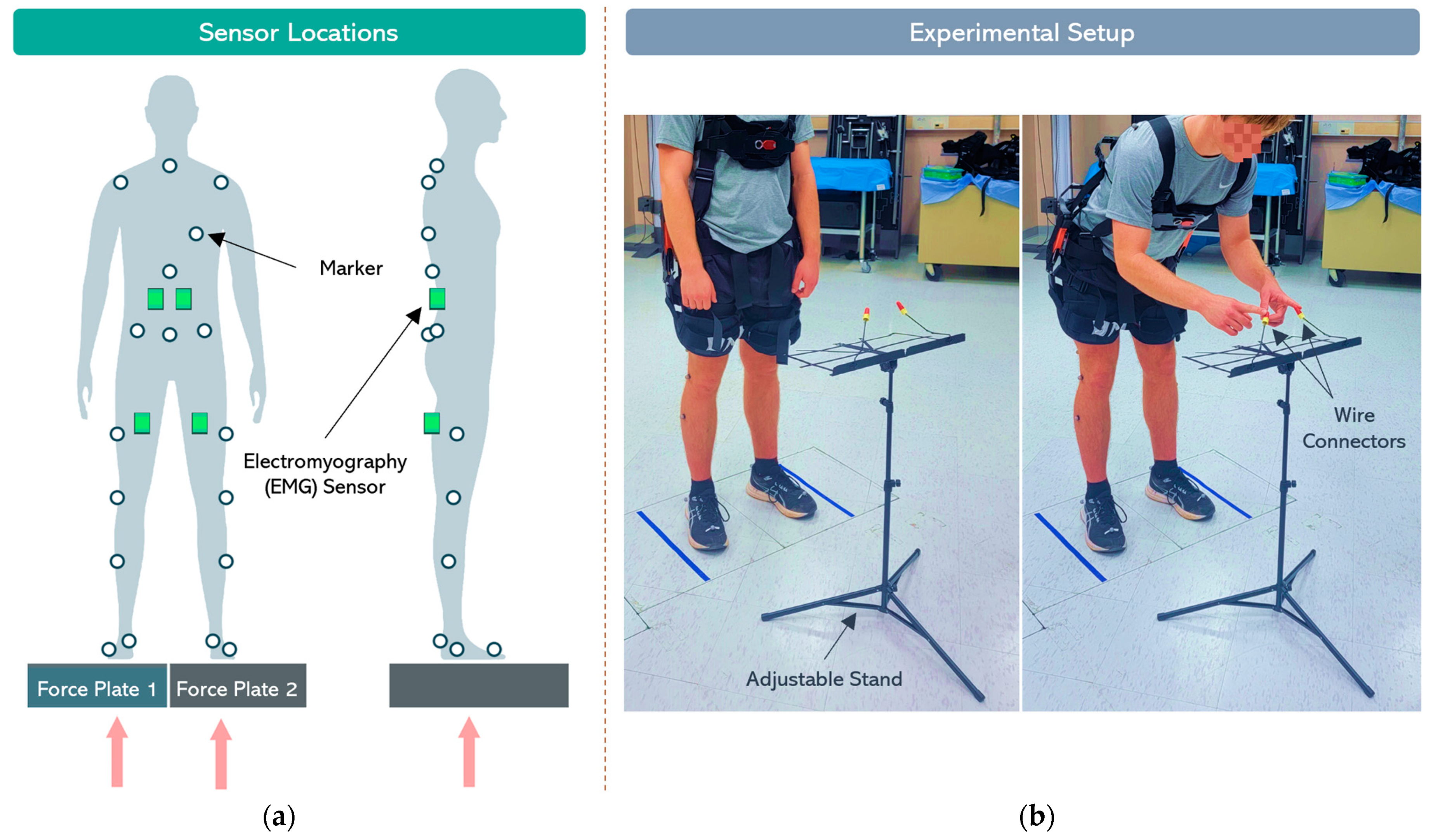
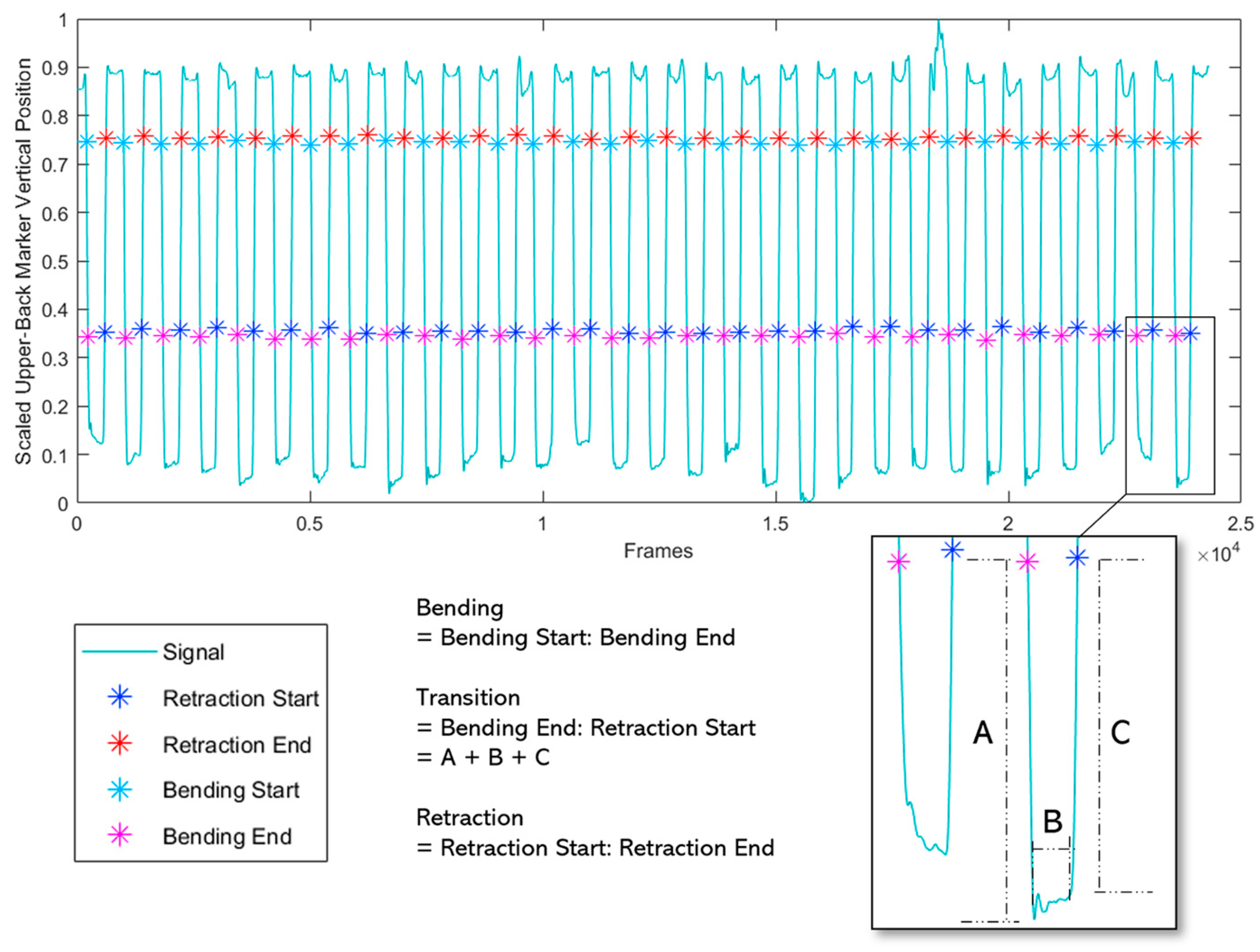
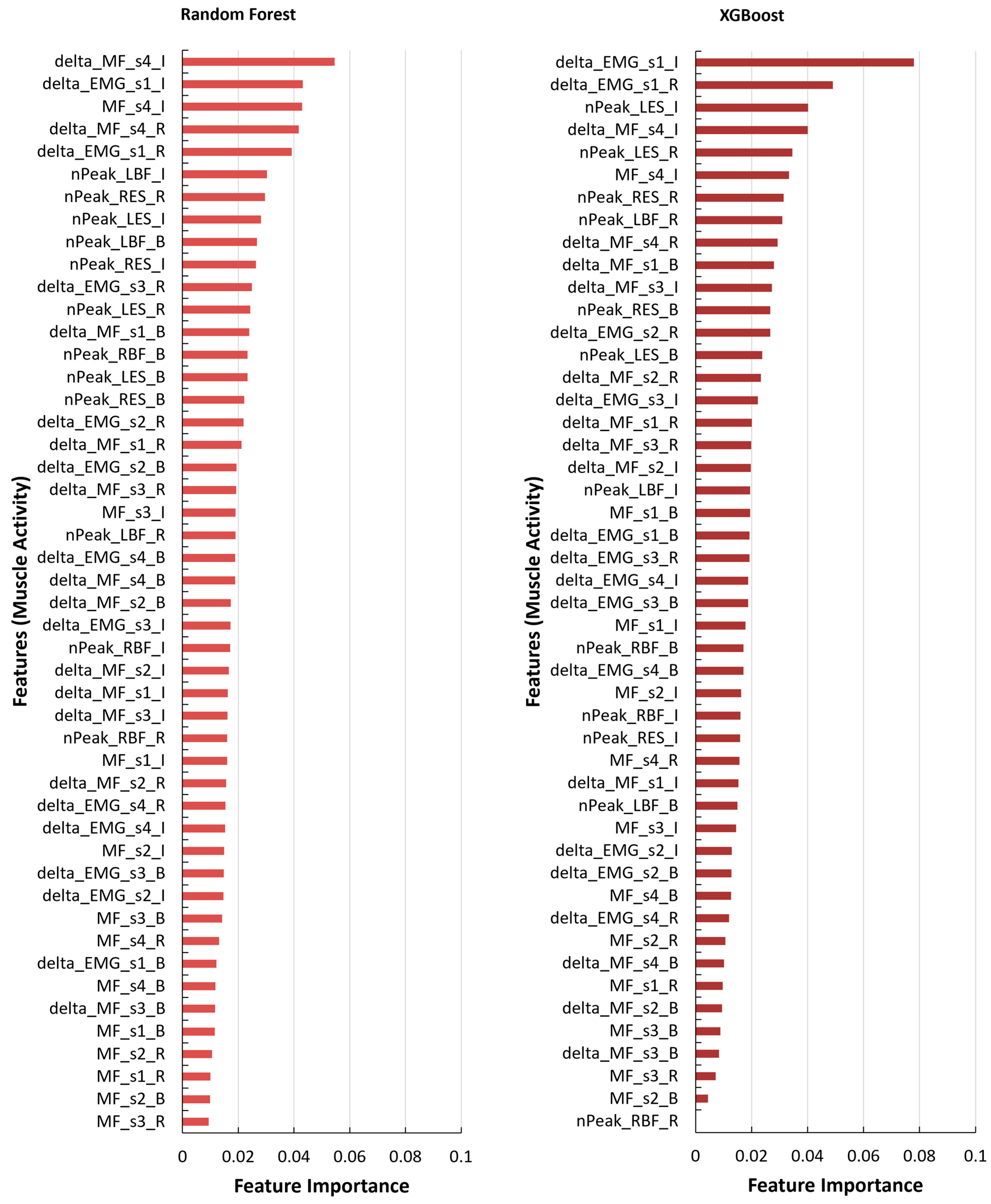


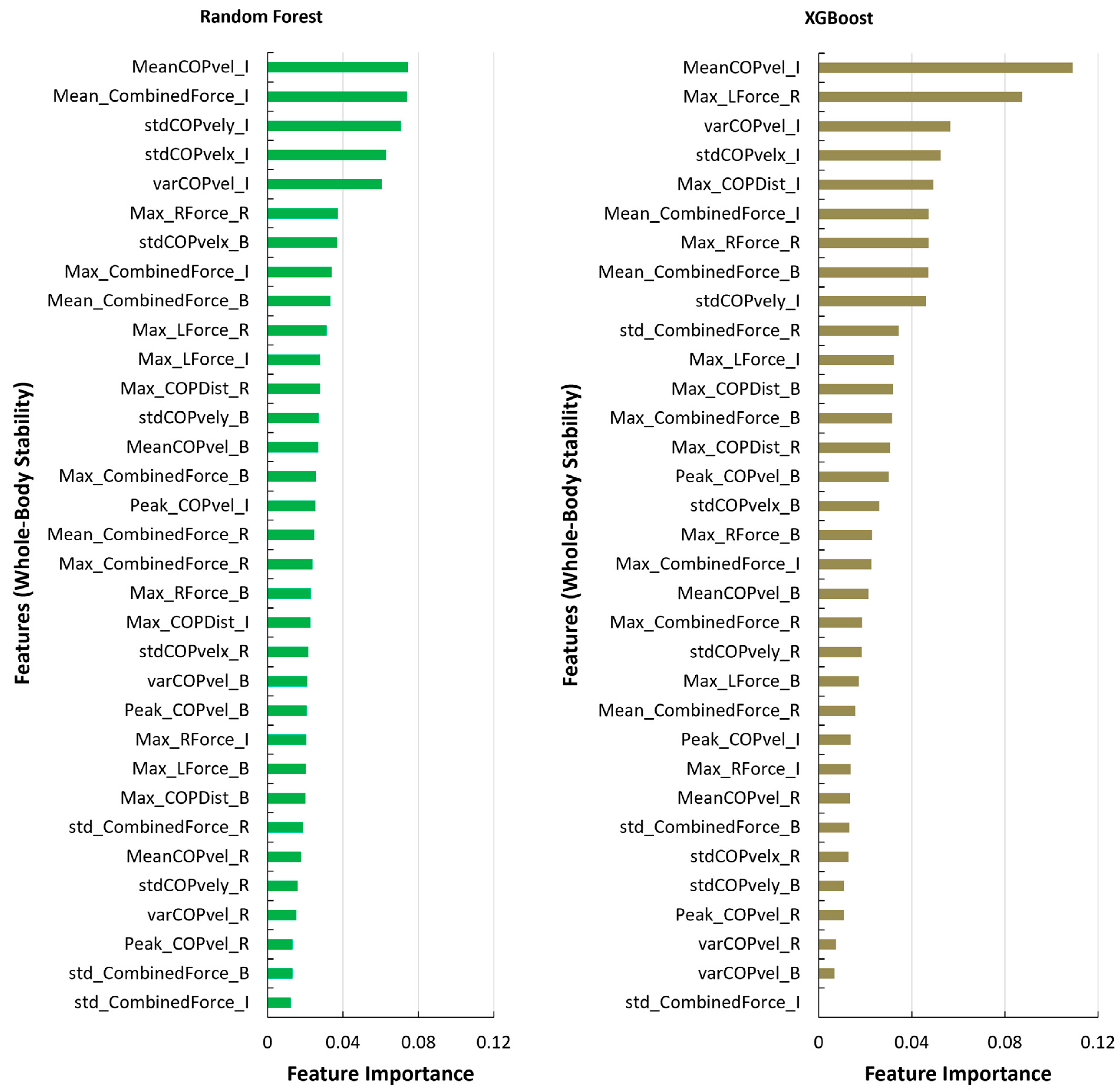
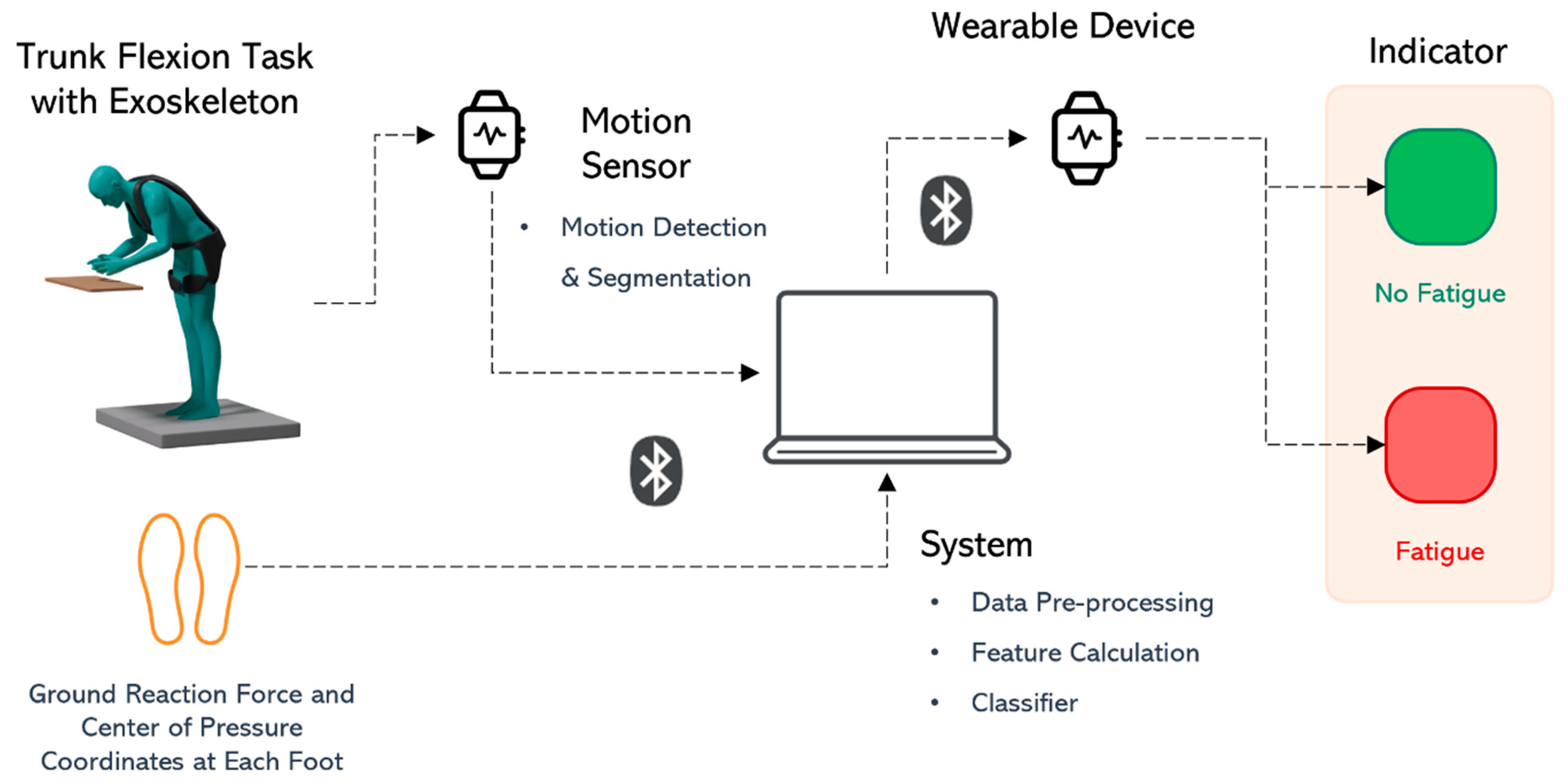
| Demographic Information | Mean (SD) | Range of Values |
|---|---|---|
| Age (yrs.) | 20.21 (2.6) | 18–28 |
| Height (cm) | 179.1 (3.7) | 172–186 |
| Weight (kg) | 72.9 (6.2) | 65.68–82.44 |
| Body mass Index (kg/m2) | 22.7 (2.4) | 19.42–27.56 |
| Chest Circumference (cm) | 89.5 (3.9) | 84–96 |
| Hip Circumference (cm) | 86.6 (6.0) | 80–98 |
| Measure (Sensor) | Total Sensors | Total Features | Sensor Location | Features per Portion |
|---|---|---|---|---|
| Trunk Movement (Motion Capture System) | 3 | 54 | Upper back, lower back, hip | Maximum of norm of velocity, mean of norm of velocity, variance in the norm of velocity. (per marker) |
| Muscle Activity (Electromyography) | 4 | 48 | Left and right erector spinae, left and right biceps femoris | Peak amplitude of RMS of signal, median frequency, change in peak amplitude of RMS of signal, change in median frequency. (per sensor) |
| Whole-Body Stability (Force Plates) | 2 | 33 | Floor-embedded, one force plate underneath each foot | Maximum distance of COP, maximum GRF at left/right foot, maximum combined GRF, mean of combined GRF, standard deviation in GRF, peak COP velocity, mean COP velocity, standard deviation of COP velocity in sagittal and coronal plane, variance in COP velocity, standard deviation of combined GRF. |
| Performance Measure | Acronym | Relation to Study Aims | Formulation |
|---|---|---|---|
| Accuracy | A | Ability of the model to detect fatigued state correctly. | |
| Sensitivity/Recall | R | Ability of the model to correctly identify all instances of the fatigued state. | |
| Specificity | S | Ability of the model to correctly identify non-fatigued states. | |
| Precision | P | Reliability of the model’s predictions of the fatigued state. | |
| F1-score | F1 | A metric to evaluate the overall effectiveness of the model in detecting fatigued states. | |
| G-index | GI | Provides an overall performance of the model in detecting fatigued states. |
| Measures | Number of Features | Classification Algorithm | A | R | S | P | F1 | GI |
|---|---|---|---|---|---|---|---|---|
| Trunk Motion (UB, LB, Hip) | 54 | SVM | 62.5 | 67.5 | 57.3 | - | - | - |
| LR | 67.8 | 69.5 | 66.2 | - | - | - | ||
| RF | 79.6 | 77.4 | 81.7 | 82.1 | 0.80 | 0.28 | ||
| XGBoost | 80 | 79.7 | 80.3 | 80.5 | 0.79 | 0.28 | ||
| Muscle Activity (LES, RES, LBF, RBF) | 48 | SVM | 74.4 | 69.2 | 79.9 | 77.6 | 0.72 | 0.38 |
| LR | 76 | 75.4 | 77 | 76.6 | 0.75 | 0.34 | ||
| RF | 94.5 | 93.6 | 95.5 | 93.7 | 93.6 | 0.09 | ||
| XGBoost | 94.6 | 94.9 | 94.5 | 94.5 | 94.6 | 0.08 | ||
| Muscle Activity (LES, RES) | 24 | SVM | 75.3 | 72.5 | 78.4 | 77.2 | 0.74 | 0.36 |
| LR | 69.4 | 66.8 | 72.3 | 70.9 | 0.68 | 0.44 | ||
| RF | 90.5 | 88.7 | 92.5 | 90.6 | 0.89 | 0.14 | ||
| XGBoost | 91.3 | 91.5 | 91.2 | 91.2 | 0.91 | 0.12 | ||
| Muscle Activity (LES) | 12 | SVM | 75.7 | 74.7 | 77.1 | 76.6 | 0.75 | 0.35 |
| LR | 66.9 | 64.7 | 69.5 | 68.2 | 0.65 | 0.48 | ||
| RF | 84.7 | 84.7 | 85 | 82.4 | 0.81 | 0.26 | ||
| XGBoost | 85.1 | 85.4 | 84.9 | 85.2 | 85.2 | 0.21 | ||
| Muscle Activity (RES) | 12 | SVM | 64.7 | 62.5 | 67.5 | 66.47 | 0.63 | 0.50 |
| LR | 61.7 | 58.7 | 65.3 | 63.1 | 0.60 | 0.55 | ||
| RF | 84.6 | 84.1 | 85.2 | 86.1 | 0.84 | 0.22 | ||
| XGBoost | 87.1 | 86.7 | 87.7 | 87.6 | 0.87 | 0.18 | ||
| Muscle Activity—single sensor (avg(LES, RES)) | 12 | SVM | 64.7 | 68.6 | 72.3 | 71.5 | 0.69 | 0.42 |
| LR | 64.3 | 61.7 | 67.4 | 65.6 | 0.62 | 0.51 | ||
| RF | 84.6 | 84.4 | 85.1 | 84.2 | 0.82 | 0.24 | ||
| XGBoost | 86.1 | 86 | 86.3 | 86.4 | 43.1 | 0.19 | ||
| Whole-Body Stability (Force Plate L/R foot) | 33 | SVM | 61.1 | 49.2 | 73.1 | 64.4 | 0.55 | 0.61 |
| LR | 52.9 | 59.5 | 46.7 | 53.2 | 0.56 | 0.62 | ||
| RF | 92.9 | 91.9 | 94.1 | 94.5 | 0.94 | 0.09 | ||
| XGBoost | 93.5 | 94.1 | 93.1 | 93.3 | 0.94 | 0.10 |
Disclaimer/Publisher’s Note: The statements, opinions and data contained in all publications are solely those of the individual author(s) and contributor(s) and not of MDPI and/or the editor(s). MDPI and/or the editor(s) disclaim responsibility for any injury to people or property resulting from any ideas, methods, instructions or products referred to in the content. |
© 2024 by the authors. Licensee MDPI, Basel, Switzerland. This article is an open access article distributed under the terms and conditions of the Creative Commons Attribution (CC BY) license (https://creativecommons.org/licenses/by/4.0/).
Share and Cite
Kuber, P.M.; Godbole, H.; Rashedi, E. Detecting Fatigue during Exoskeleton-Assisted Trunk Flexion Tasks: A Machine Learning Approach. Appl. Sci. 2024, 14, 3563. https://doi.org/10.3390/app14093563
Kuber PM, Godbole H, Rashedi E. Detecting Fatigue during Exoskeleton-Assisted Trunk Flexion Tasks: A Machine Learning Approach. Applied Sciences. 2024; 14(9):3563. https://doi.org/10.3390/app14093563
Chicago/Turabian StyleKuber, Pranav Madhav, Hrushikesh Godbole, and Ehsan Rashedi. 2024. "Detecting Fatigue during Exoskeleton-Assisted Trunk Flexion Tasks: A Machine Learning Approach" Applied Sciences 14, no. 9: 3563. https://doi.org/10.3390/app14093563
APA StyleKuber, P. M., Godbole, H., & Rashedi, E. (2024). Detecting Fatigue during Exoskeleton-Assisted Trunk Flexion Tasks: A Machine Learning Approach. Applied Sciences, 14(9), 3563. https://doi.org/10.3390/app14093563







